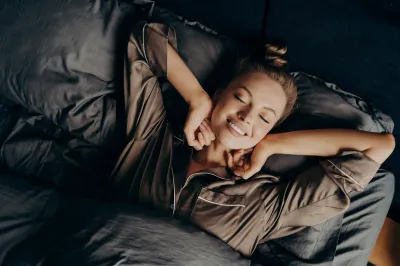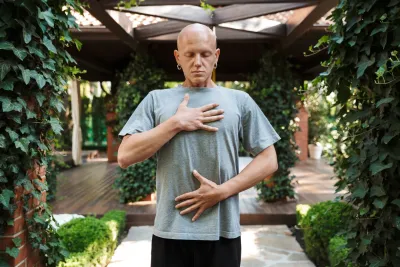
Key Takeaways
Gentle bedtime yoga helps calm your nervous system, release physical tension, and signal to your body that it’s time to slow down and rest.
- A short yoga session before bed can lower stress hormones, relax tight muscles, and support smoother transitions into sleep.
- Simple poses like Legs-Up-the-Wall and Child’s Pose help quiet the mind and encourage relaxation without raising heart rate.
- Even 5–10 minutes of light movement at night can reinforce a consistent sleep cue for your brain.
- Pairing yoga with sleep technology, such as the Chilipad Dock Pro, can help maintain a cooler sleep surface for deeper, more refreshing rest.
- These poses are beginner-friendly, floor-based, and require no flexibility or experience—making them accessible on even the toughest nights.
Struggling to fall asleep because your mind won’t shut off? You’re not alone—nighttime overthinking is a common sleep thief. The good news: a few simple habits can help quiet the noise.
You can open a book to distract your brain, sip a warm cup of herbal tea to relax your body, or try journaling to unload thoughts before going to bed.
If you find yourself still staring at the ceiling, you can add a short yoga session to your bedtime routine. Gentle, floor-based poses can calm your nervous system and make it easier to fall asleep.
How Yoga at Bedtime Can Help Your Sleep
Gentle stretches and steady breathwork make yoga a powerful tool for better rest. Each movement helps release built-up tension, easing the aches and stiffness that often keep you awake.
The focused breathing that comes with bedtime yoga does more than slow your body—it quiets your mind. By dialing down stress and anxiety, it helps you let go of the day and settle into a calmer state. Yoga also builds mindfulness, shifting your focus away from tomorrow’s to-do list and into the present moment.
That mental reset is exactly what your body needs to prepare for sleep. Add yoga to your nightly routine, and you’re not just stretching—you’re creating the right conditions for deeper, more restorative rest. See the full benefits of bedtime yoga and how to get started.
Study: A recent study revealed that gentle yoga practice may have a positive impact on treating and alleviating insomnia symptoms. [1]
Pair Bedtime Yoga with a Chilipad
Combine these top poses with the comfort of a Chilipad bed cooling system to truly transform your sleep.
How Often Should You Practice Yoga Poses
Performing yoga regularly, even just occasionally, can help improve sleep quality. But here's the thing: those who stick with yoga regularly over the long haul tend to enjoy even better sleep. [2]
Establishing a regular routine, particularly in the evenings, can effectively regulate your body's relaxation response and synchronize your sleep-wake cycle. This leads to improved sleep over time.
However, if daily yoga practice just isn't possible, engaging in it several times a week can still significantly improve your sleep patterns.
Study: A national survey found that more than half of people who practiced yoga reported that it improved their sleep, while over 85% said it helped reduce stress. [3]
Soothing Yoga Poses to Practice Before Bed
The following yoga poses are suitable for all skill levels and are particularly beginner-friendly. As you transition between these poses, it's important to focus on your breath and notice any areas of tension in your body.
If you experience any discomfort, take deep breaths and try to relax into the pose. To promote better sleep, it is recommended that you perform these poses for approximately 20 to 30 minutes before going to bed.

Cat-Cow Pose
Cat-Cow is a classic yoga move that blends gentle stretching with mindful breathing. Flowing between a rounded spine (Cat) and an arched spine (Cow), this pose targets the back, neck, and shoulders—areas that tend to hold a lot of tension.
Not only does it boost spinal flexibility, but it also helps release stiffness, ease stress in the upper body, and even stimulate digestion. To start, come onto your hands and knees with wrists stacked under shoulders and knees under hips, then move slowly through each breath-driven stretch.
Cat vs. Cow Pose: Same Stretch, Different Directions
Cat and Cow are yoga’s go-to pairing for loosening up the spine, but each one hits differently.
In Cow Pose, you tilt your pelvis back, drop your belly, and lift your chest and gaze—basically a heart opener that stretches the front body and fires up spinal extension.
Flip it to Cat Pose, and you’re tucking your pelvis, rounding your back toward the ceiling, and letting your head hang. This move deepens spinal flexion and delivers a satisfying stretch through your back.
Linked together, Cat-Cow creates a smooth flow that improves mobility, melts away tension, and recharges your nervous system—perfect for waking up, cooling down, or pressing reset after a stressful day.
How to Get Started:
We recommend doing this on the ground or a flat surface to get the most benefits from this stretch.
- Keep your hands shoulder-width apart and put your knees directly below your hips.
- Begin to inhale deeply while curving your lower back and bringing your head up, tilting your pelvis up like a “cow.”
- Exhale deeply and bring your stomach in, arching your spine and bringing your head and pelvis down like a “cat.”
- Repeat this movement for several deep breaths, syncing your breath with the movement of your spine.
The Bridge Pose
Bridge Pose, or Setu Bandhasana, is a gentle backbend that lifts your chest and gives your thighs a good stretch. In Sanskrit, setu means “bridge” and bandha means “lock,” a nod to the arch your body forms when you rise into the pose.
The Bridge pose is a great beginner pose in yoga. It is typically performed at the end of a yoga session, following a standing sequence to help warm up your spine. This pose is considered one of the foundational poses in the primary yoga series and is one of two back-bending postures in a basic flow. The other back-bending pose is the Upward-Facing Dog.
Did You Know: Though not a cure, yoga can help alleviate nighttime anxiety associated with insomnia and other sleep disorders.

Child’s Pose Stretch
A child's pose yoga stretch is considered a restorative pose. It is such a simple but beneficial yoga stretch. This particular stretch is gentle and helps your back, hips, thighs, and ankles. Child’s pose is an excellent option for stress management as it draws awareness to your breath and relaxes your body.
How to Get Started:
To begin, go on your hands and knees on the ground.
- Keep the tops of your feet on the floor (with your big toes touching).
- Lean slowly forward, keeping your buttocks on your heels, and begin to rest your forehead on the floor.
- Move your arms so they are next to your legs, with your palms facing up.
- Inhale and exhale, slowly and deeply, for at least ten breaths.
Standing Forward Bend
Standing Forward Bend is a simple yet powerful pose that stretches the entire backside of your body—from your heels up through your spine to the crown of your head.
Start by standing tall, then exhale as you hinge at the hips (not the waist) and fold forward, letting your torso hang over your legs. Need some wiggle room? Bend your knees slightly. Your arms can dangle freely, or you can grab opposite elbows for a deeper release.
Beyond the stretch, this pose helps calm the mind, ease stress, and boost circulation. It’s also known to support digestion, reduce fatigue, and quiet anxious thoughts—making it a grounding favorite in many yoga flows.

Butterfly Pose
Butterfly Pose is a go-to stretch for tight hips and lower back tension. Sitting on the floor with the soles of your feet together, you gently draw your heels toward your pelvis, creating a deep opening in the hips, inner thighs, and spine.
Perfect for anyone stiff from long hours at a desk or sore after high-intensity workouts, this pose helps boost hip mobility, improve posture, and ease everyday muscle tightness. On the mental side, Butterfly Pose promotes calm, builds body awareness, and helps reduce stress and anxiety.
How to Get Started:
- Sit on the edge of a folded blanket or cushion to stay upright and comfortable.
- Bring your feet closer to your hips for a stronger stretch.
- Use cushions or blocks under your knees or thighs for added support.
- Need extra help with posture? Sit with your back against a wall to keep your spine aligned.
Pro Tip: This pose works great in both active yoga sessions and quiet seated stretches.
Corpse Pose
Savasana, or Corpse Pose, is the ultimate wind-down in yoga—deceptively simple yet deeply effective. All you do is lie flat on your back, arms and legs relaxed, palms facing upward. It’s also the foundational posture for practices like Yoga Nidra for sleep.
While it looks effortless, Savasana is where the real reset happens. This pose gives your body and mind a chance to fully absorb the benefits of your practice. It promotes deep relaxation, melts away stress, and sharpens mental clarity.
Think of it as a conscious pause—a still, quiet space to focus on your breath, ease into calm, and end your session with a clear mind and a relaxed body.
Legs up the Wall Pose
Legs Up the Wall Pose, or Viparita Karani, is a restorative favorite that’s as simple as it is effective. You lie on your back with your legs extended vertically against a wall, forming an easy L-shape.
To get into position, sit with one hip close to the wall, then gently roll onto your back and swing your legs upward. Adjust your distance from the wall for comfort, and let your arms rest at your sides or over your belly.
This gentle inversion works wonders: it soothes tired legs, reduces swelling, eases tension, and calms the nervous system. Often used to close a yoga practice—or as a bedtime ritual—it’s a go-to pose for signaling your body that it’s time to rest.
Final Thought
Bedtime yoga isn’t just about stretching—it’s about setting the stage for real rest. These gentle poses calm the body, quiet the mind, and make it easier to slip into deep, restorative sleep.
Pair that with the cooling comfort of a Chilipad, a bed cooling system, and you’ve got the perfect recipe for drifting off faster, staying asleep longer, and waking up refreshed.
Think of it as a nightly reset: release the day’s stress, regulate your sleep environment, and let both body and mind recharge. Roll out your mat, cool down your bed, and see how much better sleep can feel.
Yoga and Sleep Frequently Asked Questions
What Time Should I Do Bedtime Yoga?
Aim to start your yoga routine 30–60 minutes before bedtime to give your body and mind time to transition into relaxation mode.
Can Yoga Really Help Me Sleep Better?
Absolutely—yoga helps lower cortisol levels, regulate your nervous system, and promote deep relaxation, all of which support better sleep.
Which Yoga Pose Helps With Insomnia?
Savasana (Corpse Pose) is your go-to. It’s the ultimate stress-release button—designed to quiet the mind, slow the breath, and ease tension from head to toe. Wrap up your bedtime flow with this one, and you’ll be well on your way to quality sleep mode.
Which Yoga Poses Are Best Before Bed?
Try calming, low-impact poses that encourage stillness and deep breathing, such as:
- Legs-Up-the-Wall (Viparita Karani)
- Child’s Pose (Balasana)
- Reclining Bound Angle (Supta Baddha Konasana)
- Supine Spinal Twist (Supta Matsyendrasana)
- Corpse Pose (Savasana)
Peer-Reviewed Research References
-
Wang, X., Li, P., Pan, C., Dai, L., Wu, Y., & Deng, Y.
The Effect of Mind-Body Therapies on Insomnia: A Systematic Review and Meta-Analysis.
Evidence-Based Complementary and Alternative Medicine, 2019.
Study Type: Systematic Review & Meta-Analysis
Key Finding: Mind-body therapies such as yoga, meditation, and tai chi significantly improved sleep quality and reduced insomnia severity, particularly by lowering stress and enhancing relaxation before bedtime.
View Study
Source URL: https://www.ncbi.nlm.nih.gov/pmc/articles/PMC6393899/
-
Vera, F. M., et al.
Subjective Sleep Quality and Hormonal Modulation in Long-Term Yoga Practitioners.
Biological Psychology, 2009.
Study Type: Observational Comparative Study
Key Finding: Long-term yoga practitioners reported better subjective sleep quality and demonstrated healthier hormonal regulation, including stress-related hormones, compared to non-practitioners.
View Study
Source URL: https://doi.org/10.1016/j.biopsycho.2009.03.008
-
Stussman, B., et al.
Wellness-Related Use of Common Complementary Health Approaches among Adults: United States, 2012.
National Center for Health Statistics, 2015.
Study Type: National Health Survey Analysis
Key Finding: A significant proportion of U.S. adults use complementary health approaches—such as yoga, meditation, and mindfulness—for wellness, stress management, and sleep support, reflecting growing adoption of non-pharmacological sleep strategies.









